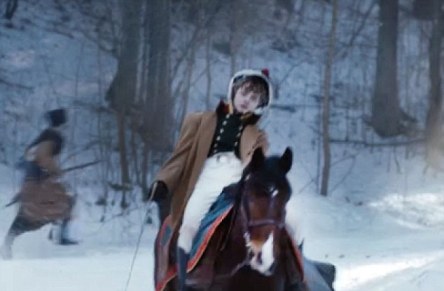I first read Tolstoy’s War and Peace in high school. At least, I read most of it.
I stopped in Volume 4, Part 4 when I realized Petya was going to die. At seventeen, with friends leaving for Viet Nam, I didn’t want to see a young recruit killed in battle. It was my first encounter with the expendable character in the hands of a master novelist.
It was a bad translation anyway, with high-flown Victorian language. I finally picked up a new copy a few summers ago, translated by Richard Pevear and Larissa Volokhonsky, and I surrendered to the pleasures of re-reading—returning, in part, to the girl I was at 17 while re-imagining St. Petersburg and Moscow, the march of Napoleon’s armies, and weaving all of that into today’s news, the laundry and gardening, stories and essays to be graded.
 There on page 1058, through smoke and dust of war, I watched Petya on his horse, galloping across the manor courtyard, slip sideways in his saddle, the horse rearing, the boy falling to the wet ground, his head pierced by a bullet. Tolstoy sets the expendable character’s death against the improbable happiness Pierre finds with Natasha in the end.
There on page 1058, through smoke and dust of war, I watched Petya on his horse, galloping across the manor courtyard, slip sideways in his saddle, the horse rearing, the boy falling to the wet ground, his head pierced by a bullet. Tolstoy sets the expendable character’s death against the improbable happiness Pierre finds with Natasha in the end.
My husband and I make a game of guessing who the expendable character is in TV crime dramas. These characters play an essential role in film and in mainstream and suspense novels, allowing an opportunity for the villain to demonstrate his villainy. Problem is, they are usually too obvious.
You can spot expendable characters by their vulnerabilities and a spark of goodness that puts them at risk. They are to be found among the marginalized. The man who has already failed once or the woman who abandoned her children is a sympathetic sinner who can be redeemed by death. A main character’s brothers or sisters, the rookie cop, the room-mate, are especially vulnerable because they live in the protagonist’s shadows where the villain is also lurking.
Because the reader must root for expendable characters, they need a significant story problem. Petya is the darling, the youngest, favorite to both Natasha and her mother. He is stifling in a world of fading gentry, caring for the women while his older brother marches off to glory. His youth and idealism make him vulnerable to the rhetoric of war, and the reader sympathizes because Tolstoy has already demonstrated that war is madness and war rhetoric is absurd. Petya’s sin is to be naive or callow enough to believe that he can make a difference where his elders have failed; these are sins of youth we’ve all forgiven.
Finally, he’s the rookie soldier. After the defeat of the French when Napoleon’s troops are in retreat, Petya is killed in a local partisan action, a death both random and devoid of purpose. This ironic turn reveals the villainy in Tolstoy’s tale—a cosmic irony, cruel at times but also comic as witnessed in the marriage at the end.
In the face of it, we must act as if the future depended on our actions, all the while laughing at ourselves for ever believing we might make a difference.
I kept Petya alive through two translations and a many years because in the hands of a master novelist, the expendable character is as memorable as the protagonist.
I loved this post 🙂
Date: Tue, 15 Mar 2016 23:48:53 +0000 To: jhurlimann8@hotmail.com
LikeLike
Thank you, Jennifer. It’s always interesting to re-read the books we loved when we were young–we get a kind of double reading and a surprising level of new meaning. I’m thinking about re-reading Thomas Hardy this summer. What favorite books would you re-visit?
LikeLike